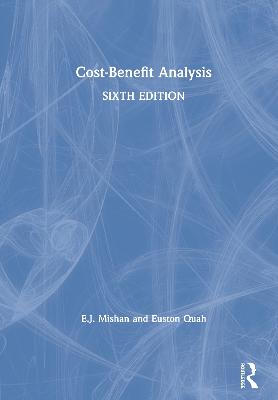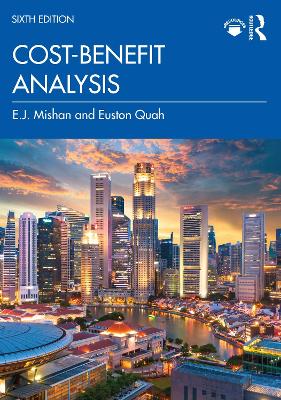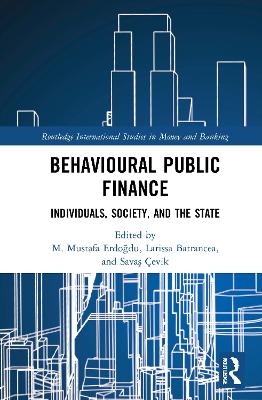Cost-Benefit Analysis
 -10%
portes grátis
-10%
portes grátis
Cost-Benefit Analysis
Quah, Euston; Mishan, E.J.
Taylor & Francis Ltd
08/2020
404
Dura
Inglês
9781138492745
15 a 20 dias
910
Descrição não disponível.
PART I - Scope and method (1) Brief historical background to cost-benefit analysis (2) What is cost-benefit analysis? (3) Framework to cost-benefit analysis PART II - Basic concepts of benefits and costs (4) Measurements of consumer surplus (5) Consumer surplus when several prices change (6) Consumer surplus when other things change (7) Introduction to the compensating variation (8) Measurements of rent (9) Is producer surplus a rent? PART III - Shadow prices and transfer payments (10) Introductory remarks (11) Opportunity cost of labour (12) Opportunity cost of unemployed labour (13) The additional benefits of using unemployed labour (14) The opportunity costs of imports (15) Transfer payments and double counting PART IV - External effects (16) Introduction to external effects (17) Adverse spillovers (18) Internalizing externalities (19) Evaluating spillovers (20) Compensating for environmental damage PART V - Investment criteria (21) Introduction to investment criteria (22) Crude investment criteria (23) The discounted present value criterion (24) The internal rate of return (25) The alleged superiority of the discounted present value criterion compared with the internal rate of return criterion and the net benefit ratio (26) Investment criteria in an ideal capital market (27) Calculation of rates of return and of time preference (28) Critique of the discounted present value criterion (I) (29) Critique of the discounted present value criterion (II) (30) The normalized compounded terminal value criterion (I) (31) The normalized compounded terminal value criterion (II) (32) The Pareto criterion and generational time (33) Cost-benefit analysis, weights and normative economics PART VI - Uncertainty (34) Risk and certainty equivalence (35) Decision rules and heuristics (I) (36) Decision rules and heuristics (II) (37) How practical are decision rules and heuristics? (38) Simple probability in decision making (39) Mixed strategies in decision making (40) Four additional strategems for coping with uncertainty PART VII - Topics frequently encountered in cost-benefit analysis (41) Valuation issues and methods (42) Benefit transfers (43) Pair-wise comparison (44) Cost-benefit analysis and behavioural economics (45) Cost-benefit analysis in developing countries (46) The value of time (47) Measuring the benefits of recreational areas (48) Travel cost method (49) Cost-benefit analysis and public health (50) The value of statistical life (51) Estimating the economic cost of air pollution on health (52) Economic cost of diseases (53) Cost-benefit analysis and the problem of locating environmentally noxious facilities (NIMBYs): an informal discussion PART VIII - Further notes and advanced materials (54) Cost-benefit analysis and the economist (Appendix 1) Cost-Effectiveness Analysis (Appendix 2) The alleged contradiction of the Kaldor-Hicks criterion (Appendix 3) The problem of second-best (Appendix 4) Origins of the Hicksian measures of consumer surplus (Appendix 5) Marginal curve measures of consumer surplus (Appendix 6) The concept and measure of rent (Appendix 7) Marginal curve measures of rent (Appendix 8) The limited applicability of property rights (Appendix 9) Deadweight loss or love's labour lost (Appendix 10) The value of human life (Appendix 11) The rate of time preference (Appendix 12) Selecting a set of investment projects for given political objectives (Appendix 13) Why cost-benefit analysis is useful for regulatory reform (Appendix 14) Valuing household production
Este título pertence ao(s) assunto(s) indicados(s). Para ver outros títulos clique no assunto desejado.
WTA;BCA;Confer;decision making;Marginal Valuation Curve;applied welfare economics;Follow;externalities;Potential Pareto Criterion;criteria;Discount Rate;appraisal;Potential Pareto Improvement;infrastructure;Consumer Surplus;benefit-cost analysis;Investment Streams;CBA;Vice Versa;economic analysis;Net Benefits;behavioural economics;Annual Net Benefits;cost-benefit analysis;Initial Outlay;non-market goods valuation;Pareto Criterion;value of household production;Demand Curve;value of statistical life;Terminal Year;Negative Net Benefit;Net Benefit Figure;Excess Benefit;Stated Preference Approaches;Travel Cost Method;Cost Benefit Criterion;Benefit Transfer;Net Benefit Stream;Net Social Benefits
PART I - Scope and method (1) Brief historical background to cost-benefit analysis (2) What is cost-benefit analysis? (3) Framework to cost-benefit analysis PART II - Basic concepts of benefits and costs (4) Measurements of consumer surplus (5) Consumer surplus when several prices change (6) Consumer surplus when other things change (7) Introduction to the compensating variation (8) Measurements of rent (9) Is producer surplus a rent? PART III - Shadow prices and transfer payments (10) Introductory remarks (11) Opportunity cost of labour (12) Opportunity cost of unemployed labour (13) The additional benefits of using unemployed labour (14) The opportunity costs of imports (15) Transfer payments and double counting PART IV - External effects (16) Introduction to external effects (17) Adverse spillovers (18) Internalizing externalities (19) Evaluating spillovers (20) Compensating for environmental damage PART V - Investment criteria (21) Introduction to investment criteria (22) Crude investment criteria (23) The discounted present value criterion (24) The internal rate of return (25) The alleged superiority of the discounted present value criterion compared with the internal rate of return criterion and the net benefit ratio (26) Investment criteria in an ideal capital market (27) Calculation of rates of return and of time preference (28) Critique of the discounted present value criterion (I) (29) Critique of the discounted present value criterion (II) (30) The normalized compounded terminal value criterion (I) (31) The normalized compounded terminal value criterion (II) (32) The Pareto criterion and generational time (33) Cost-benefit analysis, weights and normative economics PART VI - Uncertainty (34) Risk and certainty equivalence (35) Decision rules and heuristics (I) (36) Decision rules and heuristics (II) (37) How practical are decision rules and heuristics? (38) Simple probability in decision making (39) Mixed strategies in decision making (40) Four additional strategems for coping with uncertainty PART VII - Topics frequently encountered in cost-benefit analysis (41) Valuation issues and methods (42) Benefit transfers (43) Pair-wise comparison (44) Cost-benefit analysis and behavioural economics (45) Cost-benefit analysis in developing countries (46) The value of time (47) Measuring the benefits of recreational areas (48) Travel cost method (49) Cost-benefit analysis and public health (50) The value of statistical life (51) Estimating the economic cost of air pollution on health (52) Economic cost of diseases (53) Cost-benefit analysis and the problem of locating environmentally noxious facilities (NIMBYs): an informal discussion PART VIII - Further notes and advanced materials (54) Cost-benefit analysis and the economist (Appendix 1) Cost-Effectiveness Analysis (Appendix 2) The alleged contradiction of the Kaldor-Hicks criterion (Appendix 3) The problem of second-best (Appendix 4) Origins of the Hicksian measures of consumer surplus (Appendix 5) Marginal curve measures of consumer surplus (Appendix 6) The concept and measure of rent (Appendix 7) Marginal curve measures of rent (Appendix 8) The limited applicability of property rights (Appendix 9) Deadweight loss or love's labour lost (Appendix 10) The value of human life (Appendix 11) The rate of time preference (Appendix 12) Selecting a set of investment projects for given political objectives (Appendix 13) Why cost-benefit analysis is useful for regulatory reform (Appendix 14) Valuing household production
Este título pertence ao(s) assunto(s) indicados(s). Para ver outros títulos clique no assunto desejado.
WTA;BCA;Confer;decision making;Marginal Valuation Curve;applied welfare economics;Follow;externalities;Potential Pareto Criterion;criteria;Discount Rate;appraisal;Potential Pareto Improvement;infrastructure;Consumer Surplus;benefit-cost analysis;Investment Streams;CBA;Vice Versa;economic analysis;Net Benefits;behavioural economics;Annual Net Benefits;cost-benefit analysis;Initial Outlay;non-market goods valuation;Pareto Criterion;value of household production;Demand Curve;value of statistical life;Terminal Year;Negative Net Benefit;Net Benefit Figure;Excess Benefit;Stated Preference Approaches;Travel Cost Method;Cost Benefit Criterion;Benefit Transfer;Net Benefit Stream;Net Social Benefits







